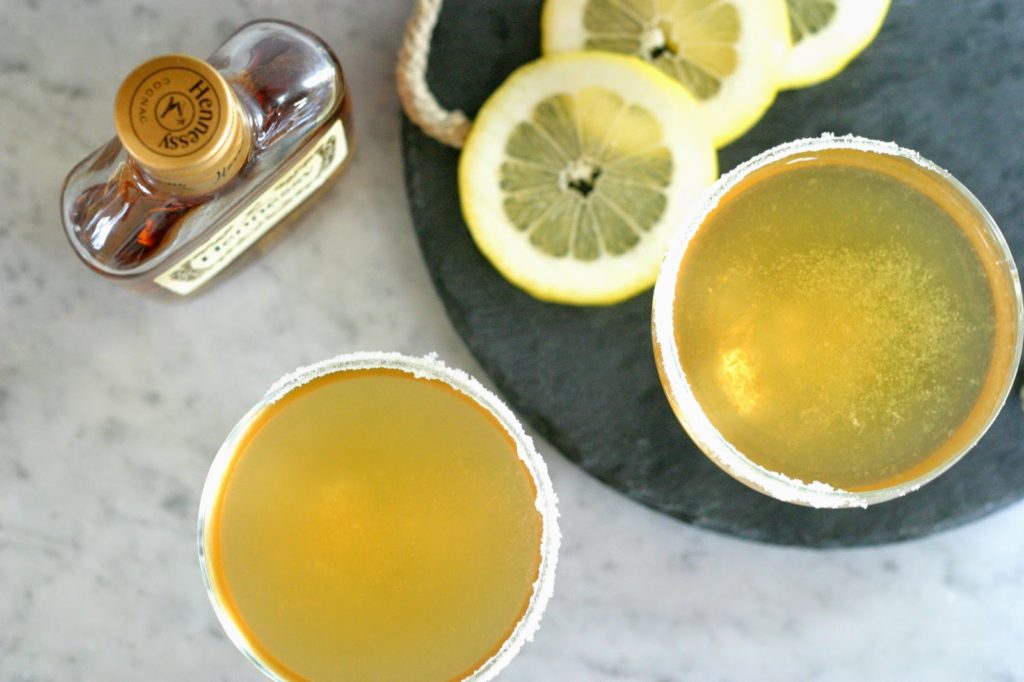Let me preface this by saying that I don’t know a thing about Cognac. I only recently learned that it is essentially the same thing as brandy, the same way champagne is the same thing as sparkling wine; Cognac is brandy that is made in Cognac, France. So the two are essentially interchangeable in cocktail recipes. Before I found this out, I knew I needed some Cognac to make a Sidecar, but I must have gone to the wrong liquor store; they only had a few bottles, and my eyes bulged at the prices. I ended up buying an itty bitty bottle of Hennessey just to try in a few cocktails. Once I found out that brandy could be substituted, I did what any good grad student would do and went to Trader Joe’s and bought a bottle of the second-cheapest brandy they had.
Since it’s our first time using brandy, we should talk about what exactly it is. I once had a friend at a party drunkenly insist that brandy was just “burnt wine,” a notion that I scoffed at, but he wasn’t entirely off base. Brandy is distilled wine, usually aged in oak casks. It is popularly served by itself as an after-dinner drink. Cognac, as I said above, is brandy made in the Cognac region of France. A similar type you may have come across is Armagnac, from (can you guess?) the Armagnac region of France.
If you buy brandy or Cognac, you may notice some letters on the label. Brandy is traditionally graded on a standard system to say how long it has been aged (though by law, only Cognac and Armagnac have to abide by these rules):
V.S. (Very Special): the youngest brandy in the blend was aged for at least two years.
V.S.O.P. (Very Superior Old Pale): the youngest brandy in the blend was aged for at least four years.
X.O. (Extra Old) or Napoleon: the youngest brandy in the blend was aged for at least six years.
My very fine Trader Joe’s brandy is Pierre Duchene V.S.O.P. Tasting it next to the V.S. Hennessy, there was a clear winner. The Hennessy is smoother and a little sweeter, while I honestly thought the brandy had a faintly unpleasant, musty taste in comparison. In cocktails, the difference is far more subtle, but not long after this experiment I finally splurged on a bottle of Pierre Ferrand Cognac. A Sidecar will be the very first drink I make with it.
The Sidecar is a really nice cocktail. It’s classic, classy, and oh-so-drinkable. I’d dare you to find me someone who doesn’t like it. Yet it was never on my cocktail radar before. Like the Gimlet, I thought of the Sidecar as a recipe from a bygone day. Which is interesting, given that they’ve been the two most pleasant surprises I’ve come across so far. They’re also both made from very simple ingredients, so it would be a safe bet to order them at any bar. And I intend to.
History: Here’s another drink with a few different possible origins. Let’s get the “but we thought of it first” out of the way: the Sidecar is very similar to both the Brandy Crusta and the Brandy Daisy, and could have evolved from either one. But while these are both American cocktails, most accounts suggest that the Sidecar originated on the other side of the pond around World War I. The Ritz Hotel in Paris claims credit for its invention, but there’s not much of a story to go along with their claim. Harry MacElhone of Harry’s New York Bar in Paris was the first to publish a recipe. In his 1922 book Harry’s ABC of Mixing Cocktails, MacElhone credits a London bartender named Pat MacGarry with the drink, but omits this is in later additions. The more popular tale is that an American army captain came to Harry’s and developed the drink, named for the fact that he rode to and from the bar in a motorcycle sidecar.
There is a division of opinion when it comes to the exact proportions of ingredients in a Sidecar. The “French school” argues for equal parts Cognac, Cointreau, and lemon juice, while the “English school” likes 2:1:1. I followed The PDT Cocktail Book, which takes the Sidecar even farther from the French version with less than one part Cointreau and lemon juice.
Sidecar
2 oz. Cognac
3/4 oz. Cointreau or triple sec
3/4 oz. lemon juice
1/4 oz. simple syrup
Combine all ingredients in a shaker. Add ice and shake until chilled. Strain into a coupe glass with a half-sugared rim.
Recipe from The PDT Cocktail Book.






